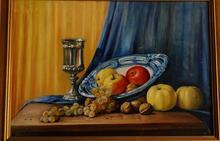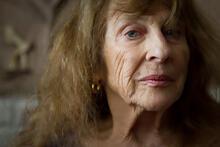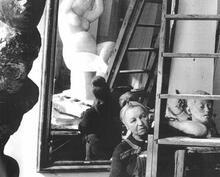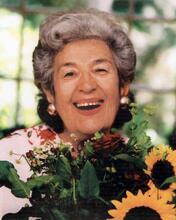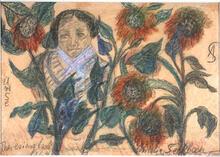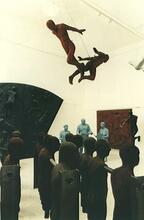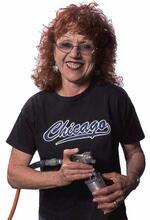Elena Kabischer-Jakerson
Elena Kabischer was a talented graphic artist, painter, and sculptor. In 1919, she became a student at The Vitebsk People’s Art College, founded by Marc Chagall. She joined a radical avant-garde group called “New Art Establishers,” creating Cubist still-life paintings and abstract “texture” compositions. In 1921 Kabischer married David Jakerson, a well-known sculptor and graphic artist. They moved to Moscow in 1923, where Kabischer joined the Advanced College of Art and adopted the Cézannist grasp of form and perception of color. Kabischer painted many Jewish shtetls among her landscapes. One of the most frequent motifs accompanying the shtetl image in her works is a Jewish funeral, a sign of tragic, irreversible changes occurring in the shtetl under Soviet rule at the end of the 1920s.
Early Life
Elena Kabischer, a graphic artist, painter and sculptor was born on March 23, 1903, in Vitebsk into the family of a craftsman. In 1916 she started studying in the private School of Drawing and Painting managed by Yehuda Pen (1854–1937), the oldest of Vitebsk painters, among whose pupils were also Marc Chagall (1887–1985) and Eliezer Lisitsky (1890–1941). Pen’s personality and his art had a deep influence on Kabischer and she kept in touch with her first teacher until his tragic death.
In 1919 Elena Kabischer became a student at The Vitebsk People’s Art College, founded by Chagall. She continued to attend painting lessons given by Pen, who taught at the college, while also completing assignments in Chagall’s “free studio.” In November 1919 Kazimir Malevich (1878–1935) arrived in Vitebsk and soon obtained a leading position at the college. At the beginning of 1920, together with his followers among the students and several teachers, he founded a radical avant-garde group called UNOVIS (Russian acronym of “New Art Establishers”). Elena Kabischer formally joined this group. Her surviving works from these years are Cubist still-life paintings and abstract “texture” compositions. However, according to her own words, she was not convinced by Malevich’s prophecies and her enthusiasm about the formal experiments was fairly superficial.
Artistic Career
In 1921 Elena Kabischer married a fellow countryman, David Jakerson (1897–1947), then already a well-known sculptor and graphic artist, who was also a teacher at the Art College. The couple had no children. When they moved to Moscow in 1923, Elena Kabischer joined VKHUTEMAS (Russian acronym for “Advanced College of Art”), where she studied in Robert Falk’s (1886–1958) painting class. There she adopted the Cézannist grasp of form and refined perception of color.
An artistic program adopted by Elena Kabischer in Falk’s studio determined the choice of still-life and landscape as the main genres in many of her paintings of the mid-1920s and the beginning of the 1930s. It is significant that there are many views of Vitebsk and also of Jewish shtetls among her landscapes. Depiction of (Yiddish) Small-town Jewish community in Eastern Europe.shtetl images and portrayal of their inhabitants’ life were an integral part of Elena Kabischer’s national self-consciousness, the continuation of her first teacher’s tradition. (In this she resembled many others of Yehuda Pen’s pupils). For all that, in her works on “the Jewish subject,” Elena Kabischer, like Pen himself, succeeds in rising above the sentimental everyday life depiction and transforms the created images into works that are rich in content and meaningful symbols. It is no coincidence, for instance, that the shtetl in her paintings looks deserted and abandoned. At the same time, one of the most frequent motifs accompanying the shtetl image in her works is a Jewish funeral, a sign of tragic, irreversible changes occurring in the shtetl under the Soviet rule at the end of the 1920s. Funeral processions walking through the uninhabited shtetl in Elena Kabischer’s paintings thus become symbols of the funeral of the shtetl itself, the ruin of the whole “old” Jewish life.
Later Career and Jewish Motifs
During the 1930s Elena Kabischer gradually moved away from “the Jewish subject,” focusing mainly on portraits of her husband and self-portraits. Painted in a free Expressionist manner, these create an inspiring image of personality. During these years, Elena Kabischer also produced a number of works reflecting topical issues, particularly, images of “the Soviet woman-toiler” and of “the new way of life.” She also participated in design projects which included designing a number of propagandist exhibitions together with David Jakerson.
At the beginning of World War II, under the impact of news of the annihilation of the Jewish population, the Jewish motifs re-emerged in her works, as well as in her husband’s. In works that recall Jewish folk-art pieces, Elena Kabischer created a series of plaster figurines and sculptural compositions using traditional Jewish zoomorphic motifs.
After suffering a severe nervous shock following her husband’s sudden death in 1949, Elena Kabischer in effect abandoned her painting and her participation in artistic life. She died in Moscow on November 19, 1990.
Kabishcher-Yakerson, Helen. Papers. The Private Archive of Hillel Kazovsky, Jerusalem.
Anferova, A., Popov, I., eds. Peski. Catalogue of the Exhibition (Russian). Moscow: 1989, 45.
Kasovsky, Grigory (Kazovsky, Hillel). The Artists of Vitebsk: Jehuda Pen and His Students. Moscow: 1992.

